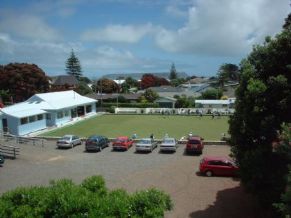How it all started
Plimmerton's name was derived from that of the acknowledged father of Wellington, John Plimmer. But he was more than just a fatherly figure. He was one of the group of prominent businessmen whose entrepreneurial drive led to the formation of the Wellington and Manawatu Railway Company, the objective of which was to open the Horowhenua and Manawatu. Plimmerton, with its attractive beaches, became one of the towns opened up as construction of the line progressed north. The line was completed in 1886.
The seaside resort of yesteryear is now becoming the northern equivalent of Oriental Bay. In 1936 the vehicular bridge of Paremata was opened, then in 1940 the Centennial Highway linking Pukerua Bay with Paekakariki was completed in time for the influx in 1942 of the American Forces to the region's staging bases. These transport enhancements benefited Plimmerton because of the access improvements from both south and north. Its popularity as a seaside resort as well as its population grew.
To meet the needs of both holiday-makers and locals the Plimmerton Bowling, Croquet and Tennis Club (Inc.) was formed in 1925. The purchase of some 2 acres in the bend of Grays Road was funded by generous donations from intending members, the issue of debentures and bank overdraft. Each sport had its formal opening in 1926. Tennis enthusiasts travelled from Wellington to enjoy the new facility as well as the beach, but firstly the Great Depression of the 1930's, then the outbreak of the Second World War in 1939, resulted in the club's demise because of lack of patronage. Its land was sold, and is now used for housing.
Plimmerton has always been a one-green club. The vicissitudes of time and circumstances have prevented expansion, the Croquet Club faced the same constraints for the 50 or more years until its re-location to Plimmerton Domain on the main highway north. Both of these greens suffered the topographically-imposed drainage problems, but by technology and assiduity these have now been overcome. To-day Plimmerton is a preferred green for the Nationals and a joy for its bowlers.
For the first third of its existence the club catered for both women and men, with, dare it be said, the inevitable result of the expectations of the men that the women would become the caterers. They left in 1952 and formed the Plimmerton Womens Bowling Club, leasing a Council-owned green located in the Plimmerton Domain. Meantime, the men entered into a catering arrangement with the Croquet Club women for whom they did the heavy work on their green.
The men set about developing their club's facilities - improving the drainage and the clubroom. Building an implement shed as well as a soil shed. Ongoing maintenance and refurbishment has enhanced the clubroom and its kitchen facilities to the point where they are an available facility for local community use.
The women, for their part, and to their great credit, developed their own club from scratch. Whereas the men's club remained in the Wellington Centre, the women competed with distinction in the Kapiti Centre. As the years went by a growing friendship developed between the men's and the women's clubs, amicable relations were progressively restored. Mixed Gala Days were played on each others greens.
In common with bowls generally, membership loss affecting both the men's and the women's clubs became a matter for continuing concern. Both clubs suffered a halving of their membership during the 1990's decade. The discussions that started in 2000 led to the return of the women to the men's green for the 2001-02 season while the affairs of the women's club were wound up. Full merger was effected in the 2002-03 season, the combined membership being 75. During the past few years there has been a resurgence of membership particularly with younger players including those in their early teens.
The only constitutional amendment needed for the merger was a name change achieved by dropping the gender from each club's title. We are now the Plimmerton Bowling Club Incorporated, but still a one green club. The vacated croquet green, not being large enough for bowls, has been developed as a car park - a blessing indeed as street parking is being squeezed by residential development.
The club is now administered by a Board of Management as recommended by Bowls New Zealand. Strategic planning and delegation of authority have enabled both the ongoing day to day affairs, and the development work to proceed unhindered. The Board meets 2-3 monthly, meetings take about 2 hours. Hitherto, the Executive Committee met monthly.

Plimmerton
Bowling Club Inc.
 Admin Login
Admin Login